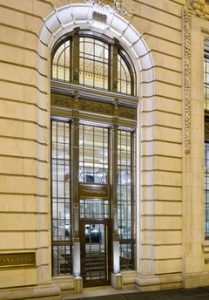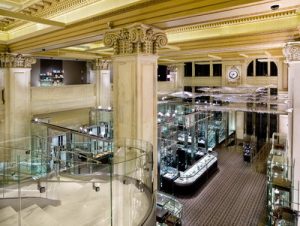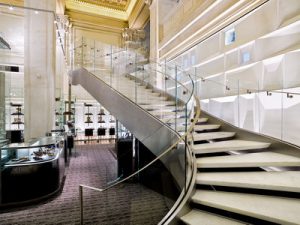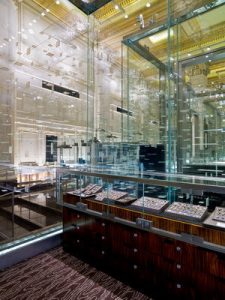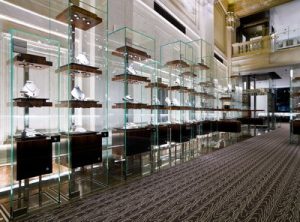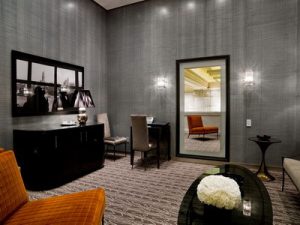I’m always in awe of the grandeur that must have been Lower Manhattan a century ago: the Beaux Arts architecture, the detailed façades, the canyons of steel that announced wealthy people were doing something very important inside those buildings.
That’s where Charles Lewis Tiffany first opened for business in 1837. And that’s where the fabled jeweler has returned 170 years later, with the October 2007 opening of its new 11,000-square-foot store on the ground floor of 37 Wall Street. The 25-story building is one of Manhattan’s first skyscrapers (constructed in 1907 as the headquarters of the Trust Co. of America).
Today, luxury condominiums line the streets along the Hudson River, while 19th Century warehouses find new life as lofts and residential spaces. Tiffany’s is an integral part of this dynamic renewal. And so it was important that the retailer’s designers and architects returned the jeweler to its roots in just the right way, with what is a spectacular marriage of traditional architecture and contemporary store design.
There’s the classic magnificence of 35-foot ceilings, marble walls, powerful crown moldings and delicately carved cornice columns – all restored to their original state through an extensive restoration process in accordance with State Historic Preservation Office (SHPO) guidelines. We’ve all been there and know how excruciating it must have been to navigate around those guidelines.
Advertisement
Once I entered, my eyes were drawn to a contemporary sculpture by lighting designer Ingo Maurer floating above the store. His overlapping metal mesh panels, suspended 20 feet above the main floor, soften the dominance of the classically high ceilings. The sculpture ambles 60 feet across the space, brought to life by an abundance of multi-faceted crystal drops, each catching and reflecting the light. It’s spectacularly appropriate in a store known for the brilliance of its diamond collection.
The main floor is divided into merchandise statements by a series of 12-foot-high glass walls. In a bold gesture that contemporizes the space, the partitions are used to distinguish each classification: men’s collections, engagement jewelry, diamonds and gemstone jewelry and finally the offerings of Tiffany’s exclusive designers, Jean Schlumberger, Paloma Picasso and Frank Gehry. While the partitions do create a sense of delineation and privacy in each room, they don’t interrupt the grandeur and visual opulence of the main selling floor. Each freestanding, double-paned glass wall is trimmed with a pattern of etched glass tiles inlaid between the panes and lit internally from below, creating a subtle but appropriate shimmer and glow.
Tiffany’s unsurpassed offering of watches is strategically positioned front and forward along the main traffic aisle. The watches are presented in a series of 10-foot-high glass and graduated rosewood towers. The maximum exposure of this important classification invites customers in and then draws them through the selling zone.
Traffic flow is further encouraged by powerful shadowbox placements at the ends of the major sightlines, referencing the retailer’s iconic shadowbox windows of the late Gene Moore. Each box makes a bold but simple statement, demanding customer attention.
The interior space is dynamically highlighted on two sides by a mezzanine and accompanying balustrade. A dramatic marble and steel staircase, neatly trimmed and protected by a glass handrail, lures shoppers to the upper level. This contemporary architectural centerpiece harmonizes with the traditional architecture, flowing in a sensual serpentine fashion across the rear elevation. A sleek glass elevator provides another access to the mezzanine. There, I was met by a registration of sterling silver, designer jewelry and Tiffany’s exclusive home collection, all presented as works of art in a gallery-like setting. The mezzanine also provides an extraordinary view to the main floor below.
Advertisement
Contemporary lighting technology energizes the space. LEDs are cast downward from crown moldings, the gracefully coffered ceiling and a series of distinctive stainless-steel bars positioned high above the showcases. The specialty lighting focuses highlights on the jewelry that is, ultimately, the story this store is trying to tell.
Because New York evolved uptown in a period of hopscotch leaps, each new area representing a different design period, Lower Manhattan’s distinctive architecture and winding narrow streets have always set it apart from the rest of the city. Sometimes, even a life-long New Yorker considered it a visit to a foreign land. Now, as the neighborhood rebuilds, it’s less a testimonial to the 17th Century pioneers and more a symbol of the city’s progressive 21st Century resolve. In keeping, Tiffany’s thoughtful polishing of the architectural jewel on Wall Street provides a compelling experience and a treasure worthy of the brand.
Client: Tiffany & Co., New York
Advertisement
Design: Yabu Pushelberg, Toronto
Ceilings Restoration: Evergreene Studio, New York
Fixtures: Modern Woodcrafts, Farmington, Conn.
Furniture: Kevin Cherry, Bronx, N.Y.; Pollaro Custom Furniture, Union, N.J.; Manzanares Furniture, Long Island City, N.Y.
Lighting: Belfer, Ocean, N.J.; Optolum, Tempe, Ariz.; Litelab, Buffalo, N.Y.
Display Forms: Lorex-CHS, Terrebonne, Que.; Virdis, Norwalk, Conn.
Wallcoverings: Studio E, New York; Xorel by Carnegie, New York; Innovations, New York; Majilite, Lowell, Mass.
Photography: Michael Weber Photography, New York
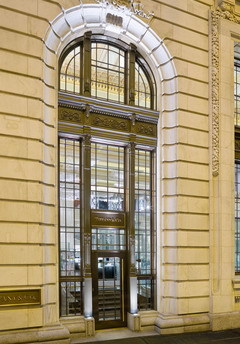

 Photo Gallery1 week ago
Photo Gallery1 week ago
 Headlines4 days ago
Headlines4 days ago
 Headlines1 week ago
Headlines1 week ago
 Headlines2 weeks ago
Headlines2 weeks ago
 Headlines1 week ago
Headlines1 week ago
 Designer Dozen1 week ago
Designer Dozen1 week ago
 Headlines1 week ago
Headlines1 week ago
 Headlines1 week ago
Headlines1 week ago
